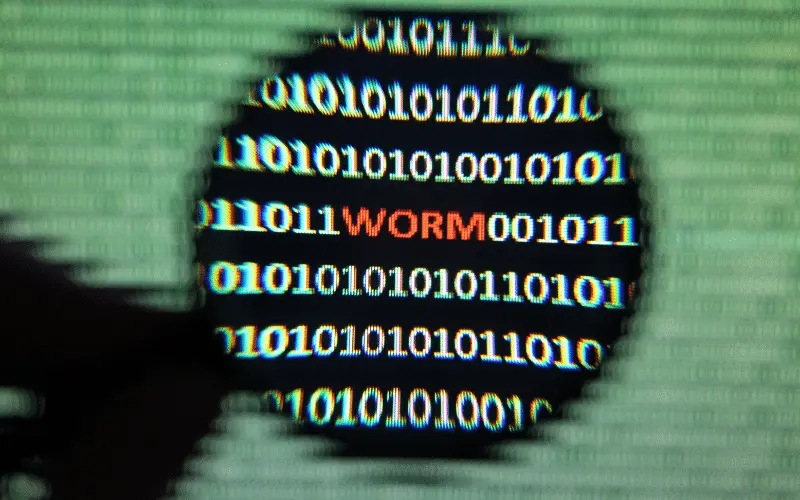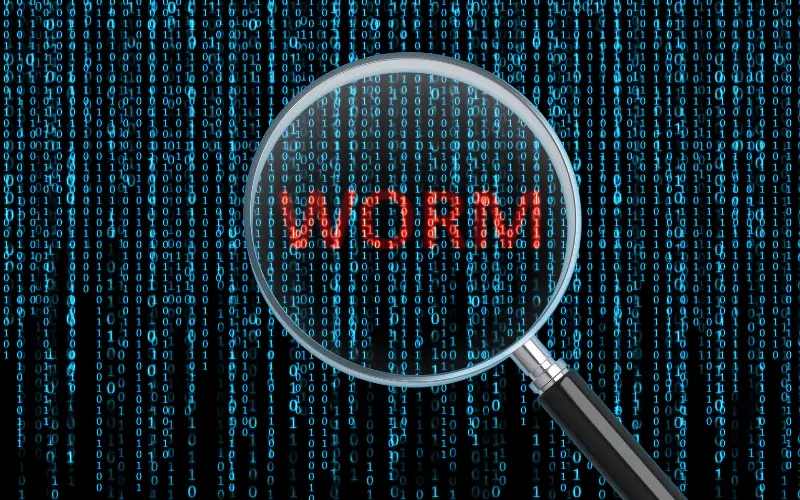One of the most important risks to cybersecurity is malware. In talking about malware, a computer worm is one of the most dangerous software that can destroy any connected device through networks and the Internet. And, in this article, we will review the most important types of computer worms with examples. So, we know how to prevent and detect them, and then remove them in case of infection.
What are computer worms? and what is the difference between them and the virus?
Computer worms are a kind of malware that can infect a computer. As we know, malware is also divided into many types, including infectious malware, under which the terms “viruses” and “worms” differ.
For illustration, HIV can be defined as malware transmitted through other programs. in other words. The virus is an internal intruder that can move through a file or other intact software (e.g., transmission through an Excel file transmitted from one device to another).
Nor does HIV work alone, unlike worms that are self-programming programs that do not need other programs to spread themselves. It often travels through the network from one device to another.

How do computer worms spread?
Firstly, Mobile worms on the computer require the user’s action to spread, such as clicking on a link he received via email or stopping it on a particular web page for example. Then the computer worm can easily spread without user intervention. Finally, the worm becomes active on the victim’s device.
The spread of worms in our time has become much easier and can be done in any way through internet networks. Previously, computer worms were spread through Cal USB’s infected storage media. Thus, when installing this storage unit on any system, the computer worms infect the related devices easily.
Types of computer worms
There are many types of worms or mobile malware including the following:
1. Email worms
Email worms work by creating outgoing messages and sending them to all addresses on the user’s contact list. These messages include malicious files that infect the new system when the user opens them.
Mobile viruses in email usually use phishing techniques to encourage users to open the attached file.
2. Instant message worms (IM Worm)
They resemble email worms, where mobile worms for instant messages are hidden in attachments or links. The worm is thus spread through the list of infected user contacts. Both are dangerous computer worms. However, the only difference between them is that instead of moving through email, instant messaging worms move as an instant message through the chat service.
These worms need enough time to spread on the computer. Thus, if the worm does not have enough time to repeat itself, then we can stop it from spreading by changing the password at the expense of the user’s chat service.
3. File sharing worms (Stuxnet)
Mobile worms for file sharing are software hidden as media files. Stuxnet worms are one of the most popular mobile worms.
File-sharing worms are also widely used to target industrial environments. Including power facilities and water supply services, as well as sewage plants.
4. Crypto worms
Crypto worms work by encrypting data on the victim’s system. This type of mobile worm can also be used in ransomware attacks, where perpetrators follow the victim and deforce him to pay for a key to decrypt his files.
5. Internet worms
Among computer worms, internet worms particularly target popular websites with weak security. This is by infecting the computer that accesses the website.
Internet worms are thus spread to other devices contacted by the infected device through Internet connections and private networks.
Examples of worms
6. Morris Worm
The Morris computer worm, launched in 1988, is the first computer worm to spread widely online. Robert Taban Morris Jr invented the worm. and it was the world’s first worm on the Internet site with the name “ARPANET”. This worm targeted weaknesses in many different Unix systems. It has been able to infect the system more than once. therefore, Eliminating these worms is very difficult. The worm can also destroy the infected host.
7. ILOVEYOU worm
The iloveyou worm was one of the most harmful mobile worms ever, launched in 2000 and published malware through email attachments that appeared to be text files, as the scripts were run in instant chat sessions and executive files that were renamed common system file names.
iloveyou when targeted victims open the email facility, and the malware re-sends itself to all the victim’s contacts.
8. Stuxnet
The Stuxnet computer worm is a file-sharing worm first identified in 2010, security researchers determined that the worm was created by US and Israeli intelligence agencies to interfere in the production of Iranian nuclear weapons.
Stuxnet is programmed to spread via USB drives and take advantage of the defects in the Windows operating system to spread, ultimately causing the nuclear centrifuges to break down.
Dangers of computer worms
Although some worms are designed to do nothing more than deploy themselves into new victim systems, most worms are associated with hidden roots or other malware that can cause additional damage and risks.

How to protect systems from computer worms?
Protecting systems from computer worms is very important. because Prevention is the best treatment. Actions that will help prevent the risk of computer viruses include:
- OS updates and UL software patches.
- Use firewalls to reduce malware access to systems.
- Use antivirus software to prevent the operation of malware.
- Do not click on attachments or links in emails or other messaging apps that may expose systems to malware.
- Use encryption to protect sensitive data stored on computers, servers, and mobile devices.
How do we detect a mobile computer worm on our device?
It may be difficult to detect a mobile worm on our devices, but there are some signs that a computer worm exists which are as follows:
- Poor computer performance over time, little bandwidth with no clear explanation.
- Unexpectedly freezing or disrupting the system.
- Unusual behavior of the system, including software implemented or terminated without user intervention.
- The sudden appearance of unfamiliar files or icons, or the unexpected disappearance of files or symbols messages.
- Warning of operating system or antivirus software.
- Emails sent to contacts that the user has not already sent.
How do we remove mobile computer worms from our devices?
Removing mobile worms from a computer can be very difficult. The system may need to reset, which requires reinstalling all software. It is therefore recommended to use a known and secure computer to download any updates or software required to an external storage device and then install them on the affected device.
If it is possible to identify the mobile worms that infect the system. Specific instructions or tools may be available to remove it without having to scan the system completely.
The system must also be separated from the Internet or any wired or wireless network, before attempting to remove mobile computer worms. Also, remove any non-permanent storage devices such as USB or other external hard drives. Check it separately for injury.
Once the system is separated from the network, the following must be done:
- First, update all antivirus programs.
- Then check the computer using the updated antivirus software.
- The antivirus software was then used to remove any malware and mobile viruses found to clean infected files.
- Finally, make sure that the operating system and all applications are updated and corrected.


